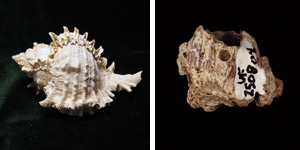
This Fossil Friday we have a barnacle from the Pleistocene Armuelles Formation. Barnacles are crustacean arthropods (Phylum Arthropoda, Subphylum Crustacea), so they are somewhat related to crabs and lobsters. Something special about this particular barnacle is the incomplete hole in one of its plates. This barnacle was preyed upon by a drilling predator just like many other shelled marine invertebrates, such as clams, snails and crabs, to name a few. Possible culprits behind these drill holes, which are still around and continue to drill today, are muricid snails (see photo) and octopods.
To read more about this specimen and barnacles as victims of drilling predators, check out the publication here.
Reference:
Klompmaker, A.A., R.W. Portell, S.E. Lad, and M. Kowalewski. 2015. The fossil record of drilling predation on barnacles. Palaeogeography, Palaeoclimatology, Palaeoecology 426: 95–111. doi:10.1016/j.palaeo.2015.02.035